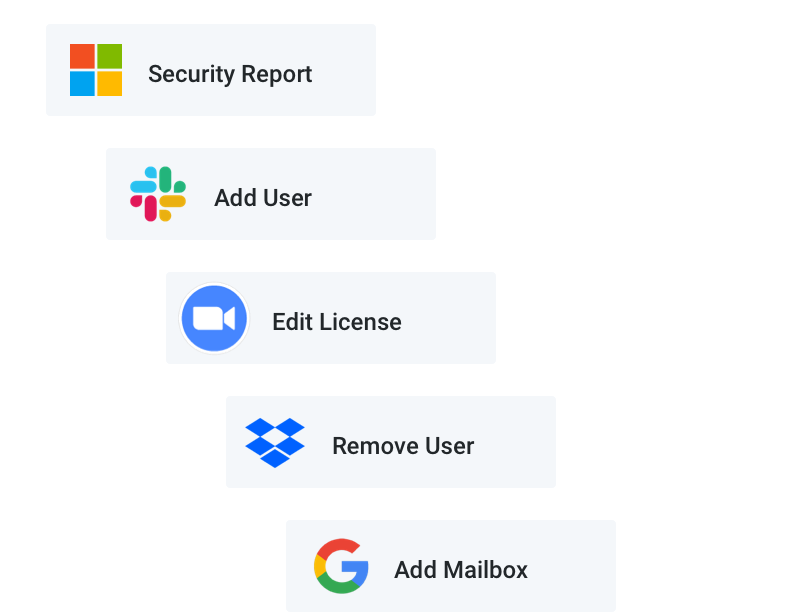A single application to command the cloud. A powerful way to automate workflows and tasks for help desk productivity.
Cloud Manager is built around six core areas of technology that empower you to easily administer thousands of tasks across SaaS, PaaS, IaaS, and devices in a fraction of time. Easily transform PowerShell workflows into automation for generalist use in an intuitive application, all backed by robust security layers, role-based controls, and reporting.
Center
Center
& Auditing
& Auditing
Connect
Connect
Command Center
Help desk automation app to resolve tickets faster and reduce escalations
Today, frontline help desk technicians are stuck with pre-cloud legacy IT tools that leave you hopping through dozens of portals, checklists and tons of manual work. Usage of PowerShell scripts is often complex, necessitating technical expertise. The user-friendly, no-code Command Center is a centralized automation application built for the way support desks operate.
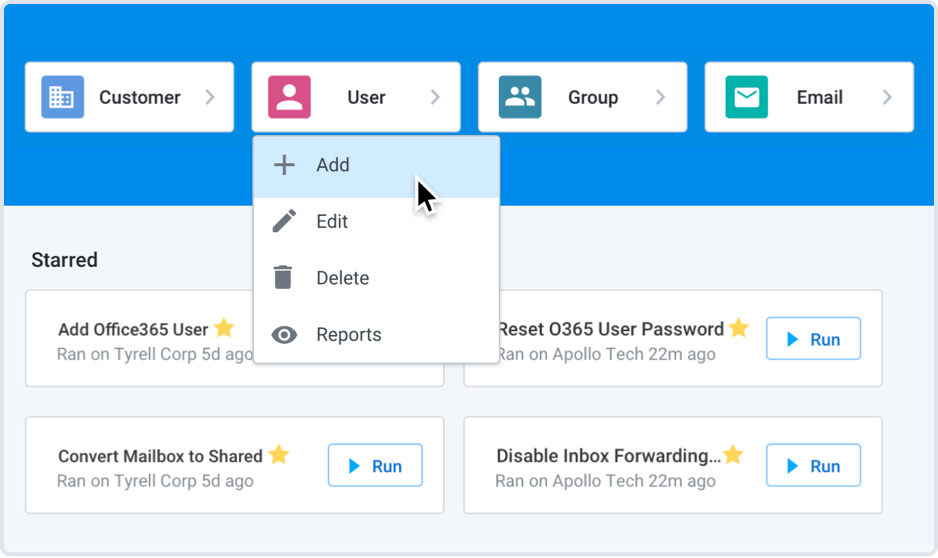
Multi-customer, multi-service support
Administer thousands of tasks across all your customers, cloud connected services, and devices – Microsoft, Google, Dropbox, Slack, Zoom, and more
Cloud admin made easy
Easily discover, browse, and run automation in context with a pre-loaded library for multi-SaaS user onboarding, permissions and delegation, license management, usage reports, and more
Deliver great customer service
Resolve tickets on the first call 75% of the time with greater security and fewer escalations
Cross-team and customer visibility
Get detailed context into team activity and explore automation usage to optimize operations
WorkBench
Appify IT workflow automation for efficient help desk reuse
Efficiently automate complex, multi-step workflows across cloud, hybrid, or even on-premises workloads using PowerShell. Transform complex, multi-step PowerShell script IP into an easy-to-run application for the Help Desk with the click of a button.
Easy building blocks
Leverage a library of 7,000+ cross-SaaS commands plus SkyKick-provided proven script templates for easy customization or creation
Build, save, and manage automation
A connected PowerShell development environment to efficiently write, assemble, and reuse scripts across connected customers and services
Enable Help Desk
Single-click deployment of tested automation to the Command Center for help desk use with easy-to-complete GUI forms
Script cross-cloud
Apply your PowerShell expertise to automate workflows across SaaS, PaaS, and IaaS, no need to learn vendor-specific APIs
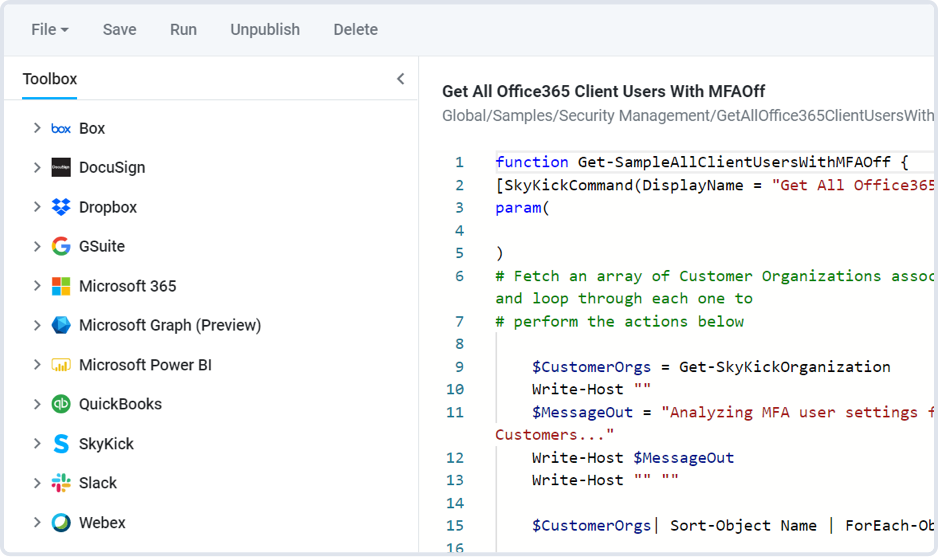
Strengthen Security and Compliance
Get visibility, take action, and strengthen security across your business and customers
Cloud Manager was designed to reduce the risk of security exposure created by current non-secure tools and manual processes. Leverage automation to standardize critical security workflows ranging from MFA enablement, mailbox forwarding rules, and more
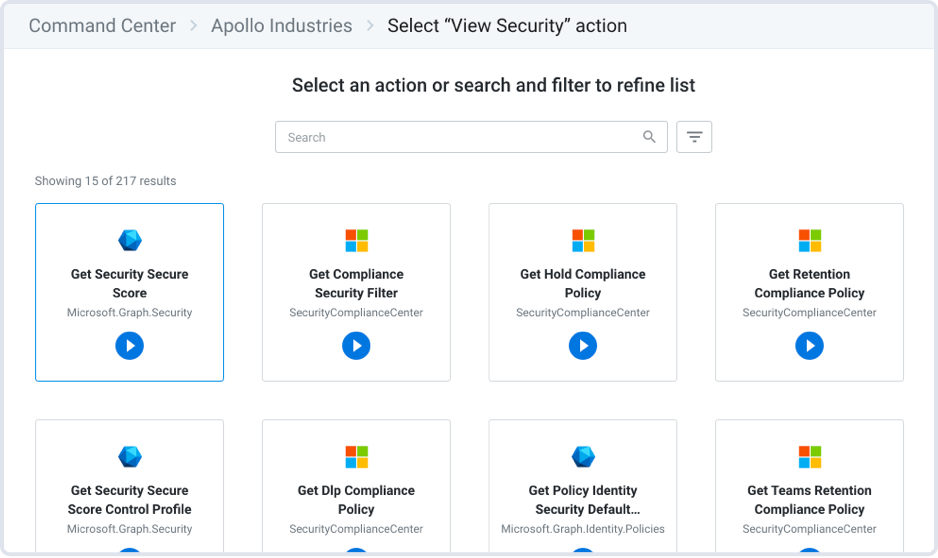
Assessments & Remediation
Easily run security assessments across customers and services, and put the power of automation to safely remediate the gaps
Tokenized authentication model
Proprietary connector technology establishes secure connections to apps, eliminates the need for non-secure password sharing
Role-based Permissions
Define and control privileged access roles within your team
Insights and Reporting
Many IT Providers lack visibility into their customers’ apps and environment, and the ways that their help desk team is interacting with them. Get a unified view of your team, services, and customers to make informed, data-driven decisions.
Cross-tenant and app reports
Get aggregated data across tenants and XaaS to uncover critical insights and take action
Reporting Add-In for PowerBI
Create reports within PowerBI using a data connection to Cloud Manager and download ready-to-use templates for analyzing activities, commands, tenants, and customers
Automatic audit trail
View detailed records of all team activities to optimize operational efficiency and service delivery
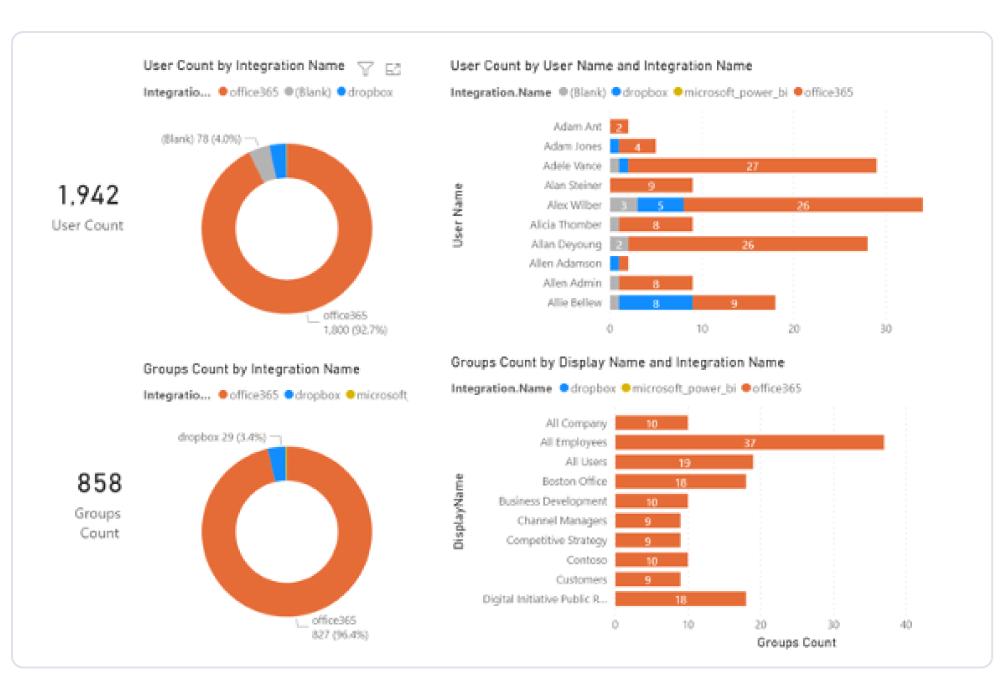
Cloud Connect
Simplify hybrid management with Cloud Connect
Cloud Manager leverages a cloud-first, serverless IoT technology layer for secure authentication. A lightweight agent connects devices to our proprietary engine through the Microsoft IoT Hub platform– enabling you to seamlessly manage hybrid solutions within a single application.
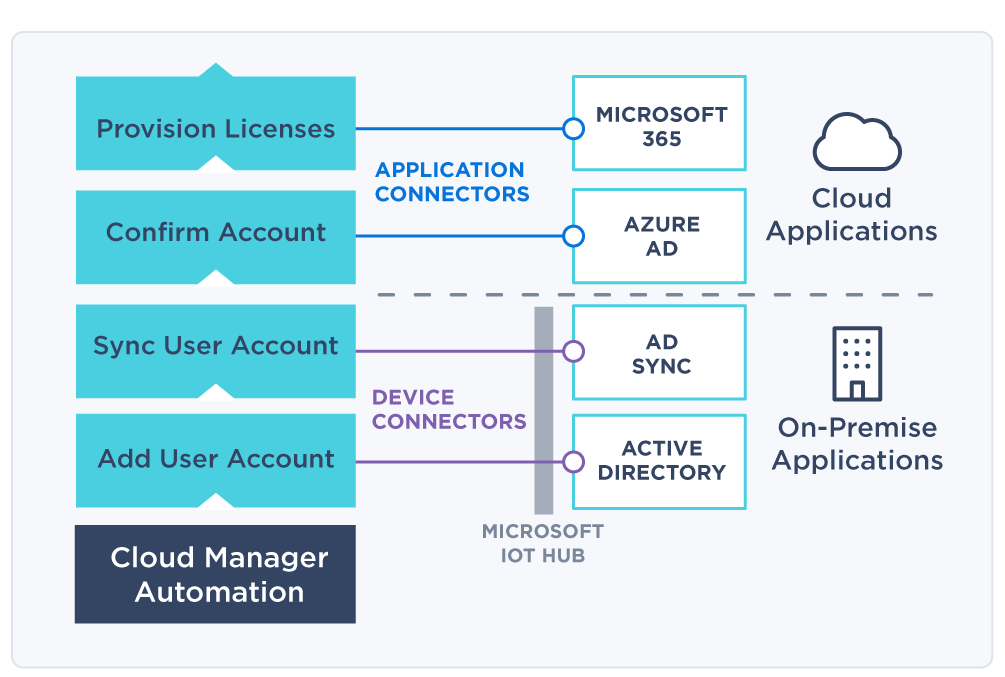
Lightweight agent
Facilitate secure Cloud Manager connection via Microsoft IoT Hub
Automatic indexing
Get visibility into supported PowerShell commands on devices
Active Directory orchestration
Streamline syncing of on-prem AD and changes to the cloud
Help Desk Enablement
Tier 1 can run pre-built automation, no need to understand physical architecture to support customers
Connector Engine
Unify all your cloud and hybrid services
Eliminate the fragmentation and inefficiency of operating with disparate cloud services, vendor-specific identities, and proprietary management APIs. By connecting a portfolio of SaaS, IaaS and PaaS offerings into one platform, it makes it possible to achieve no-code and low-code automation of XaaS tenants using the popular PowerShell language.
Vendor-agnostic connector technology
Configure and activate token-based access to customer SaaS apps
Hybrid and Cloud
Securely connect devices to facilitate management of solutions and devices across cloud and on-premises
Multi-tenant
Bring all your customer cloud apps and data together for seamless switching

How Partners are using Cloud Manager to grow cloud businesses in Microsoft and beyond
Frequently asked questions
How does Cloud Manager help IT Providers administer Microsoft 365?
Cloud Manager enables comprehensive administration of Microsoft 365 services with multi-tenant and cross-portal automation through built-in connectors to Microsoft services and modules. Instead of hopping between admin portals and PowerShell, Cloud Manager empowers Help Desk technicians to easily administer hundreds of support tasks for Microsoft 365 and other SaaS across customers. What’s more, engineers can easily create, save, manage, and share PowerShell workflow automation that extends across workloads.
The Microsoft 365 connector includes the Azure AD and MSOnline modules along with six optional modules that cover the breadth of deployment, configuration, management, and support actions for Microsoft 365. These include all PowerShell cmdlets, including many that can be run immediately without PowerShell expertise. Cloud Manager supports modules for Azure Information Protection (AIP), Exchange Online, Microsoft Teams, SharePoint Online, Security & Compliance, and Skype for Business and connectors for Microsoft Graph, Azure, Endpoint Manager (Intune).
For more information, see Microsoft 365 connectors and modules
How does Cloud Manager help IT providers manage SaaS applications?
Recent events have accelerated an already fast-growing $119B SaaS application market, creating significant management and security challenges for SMBs. However, many MSPs have chosen not to support many SaaS services, if any, beyond Microsoft due to each SaaS service having its own unique management portal to learn and navigate. This makes it difficult to scale, as the more services one manages the more portals there are to learn to fulfill even the simplest support requests.
Cloud Manager provides a central interface for multi-SaaS automation. With pre-built, tested commands that communicate with SaaS application APIs, even the frontline Help Desk can safely and securely run multi-SaaS, pre-authenticated automation through the Command Center.
Can I manage devices with Cloud Manager?
Cloud Manager offers the capability to connect to and manage devices from within the Cloud Manager interface. This enables coordinated administration of on-prem devices used in hybrid environments.
Cloud Manager utilizes Microsoft IoT Hub and the Cloud Manager Device Agent to facilitate communication between Cloud Manager and the connected device. This lightweight agent is installed on the device and registers the device with IoT Hub to establish and maintain secure communication. It also indexes the supported PowerShell commands on the device allowing them to be run from Cloud Manager. Additionally, by creating a connection to the Sync Server, Partners can build commands that sync to the cloud immediately rather than waiting for the next scheduled sync.
For more information, see Adding connectors to on-premises devices.
How is Cloud Manager different than an RMM tool?
RMM tools are typically focused on the remote monitoring and management of on-premises hardware and OS endpoints. And while many can automate some tasks across tenants within that environment, they typically do not scale to support cloud-based applications. Only Cloud Manager can automate and manage both multi-tenant cloud and on-premises endpoints with the ability to easily and efficiently automate tasks across SaaS applications, all from a single interface.
IT Providers can easily leverage multi-tenant capabilities in Cloud Manager to more efficiently monitor, manage, discover, and report on endpoints across customers. Cloud Manager includes a connector to Microsoft Endpoint Manager, which encompasses the convergence of Intune and System Center Configuration Manager (ConfigMgr) and the Device Management Admin Center (DMAC) and Desktop Analytics. Using the cross-tenant capabilities of Cloud Manager, along with its Endpoint Manager connector and over 1,000 built-in cmdlets, you can create automation to standardize endpoint management settings and policies for each customer you add to your support practice, and empower your frontline Help Desk to fulfill support requests related to endpoint management.



